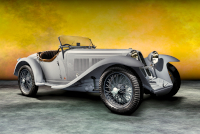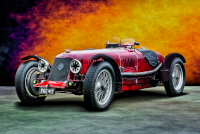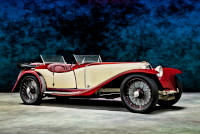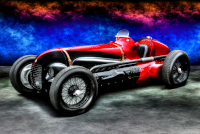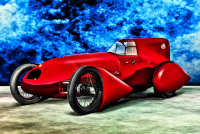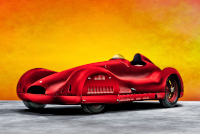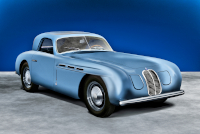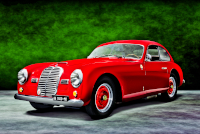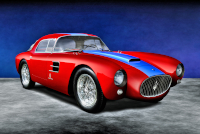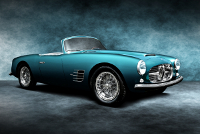
Profiles: 10
Images: 59
Maserati
Established 1914: Bologna, ItalyAt its heart a simple, yet obsessive performance garage, many would not recognize the best of Maserati production because it is dedicated to racing. Originally founded by Alfieri, Ettore, and Ernesto, the firm properly materializes in 1926 with the purchase of the Diatto company remnants. At this point, eldest brother Carlo has predeceased his siblings by some unfortunate distance, yet demonstrated enough ingenuity in a short time to herald Alfieri's rise to prominence. Brother Bindo opts to remain at Isotta Fraschini, where he had partnered Alfieri for some time. And Mario, the only brother not interested in mechanics, is a skilled artist whom Alfieri asks to design his marque's emblem. Those three Maserati brothers operate a successful racing concern until Alfieri's death in 1932, which brings Bindo back from Isotta Fraschini to rejoin as president, while Ernesto assumes technical leadership.
In reviewing Maserati family history, similarities between they and the Duesenberg brothers surface time and again. These are each families of seven children whose younger members follow the initiative of the eldest outgoing scion (Carlo and Henry, respectively). Those who then forge the family's name in history are self-taught engineers of extraordinary aptitude with a naturally sporting disposition; they move about and gather industry experience wherever they can, sometimes together and sometimes apart. They design and build all manner of machines, and find success in numerous technical domains. Serendipitously, both families set land speed records, and both enjoy a spell of good fortune at the Indy 500. Indeed, Duesenberg and Maserati are two of the only period race car producers to campaign their cars across the Atlantic, let alone to find success. Both families also suffer the untimely loss of their key enterprising motivator (Alfieri and Frederick, in this case).
Both great names also depend on the patronage of others. Two benefactors champion Maserati—first the Marquis Diego de Sterlich, and later Adolfo Orsi, whereas E.L. Cord is a rather Orsi-like figure in the Duesenberg story. Adolfo Orsi sees Maserati transition from Bologna to Modena in 1937. With the Orsi family in control, the surviving Maserati brothers established O.S.C.A., but their influence remains at their namesake factory in the technical development of Maserati racing cars. Financial necessity at last brings Maserati to public roads in the post-War era, and the passion for racing persists well into the 1960s.
These four decades produce the pure Maserati car, Italy's first true four-wheel obsession. These are the cars that overtake a young Enzo Ferrari, giving him a target at which to aim, because Maserati are the cars every ambitious Italian driver must own. A true Maserati is a bespoke gem, not unlike the early Duesenberg, a car of intuitively potent design finished to an exceedingly high standard. For these reasons, 12cylinders prioritizes Maserati above other Modenese concessions, however brief the sampling may be.
Maserati 4CS 1100, Brianza, #1114, 1932
The 1932 Milano show car, depicted here in (near) original form. Now a 1500 cc roadster, chassis #1114 underwent race alterations in the hands of Count Castelbarco, sheltered in Eritrea during World War II, and raced post-War in the UK.
QI: 3.851 ★ ★ ★
7 images
Mar 26, 2025
Maserati 8C 3000 Biposto, #3004, 1932
The 8C 3000 is the final biposto evolution, precursor to the successful 8CM, and the car that tempts Nuvolari from Scuderia Ferrari to Maserati.
QI: 2.533 ★ ★
2 images
Mar 26, 2025
Maserati Tipo 26M (8C 2500) Sport Double Phaeton, Castagna, #2521, 1932
The dual-cowl sports tourer that no longer exists, a true chimera, and the first true Maserati road car.
QI: 2.119 ★
1 image
Mar 26, 2025
The first V-8 Grand Prix car, quickly forgotten but technically advanced. This is the last of four built, which George Weaver christens 'Poison Lil' and pilots in the first post-War American road race.
QI: 4.825 ★ ★ ★
16 images
Mar 26, 2025
Maserati Siluro 4CM 1500 Carenato, Viotti, #1536, 1937
The lost land speed record car designed by Centro Sperimentale Aeronautico di Guidonia for Giuseppe Furmanik. The Siluro is a special 1500 cc 4-cylinder torpedo built on a 6CM chassis by Viotti.
QI: 3.123 ★ ★
1 image
Mar 26, 2025
Maserati 4CL 1500 Aerodinamica, Stabilimenti Farina, #1565, 1939
The lost 4CL streamliner prepared for Luigi Villoresi's run at the 1939 Gran Premio di Tripoli, the special voiturette race famously nabbed by the one-off Mercedes-Benz W165.
QI: 3.535 ★ ★ ★
3 images
Mar 26, 2025
Maserati A6 1500 Prototipo Turismo Coupé, Pinin Farina, #051, 1947
In clandestine development from 1940, chassis #051 debuts at the 1947 Geneva Motor Show, remarkably advanced counterpoint to the Cisitalia's classical form. The car later disappears, and thus loses its standing in the history of automotive design.
QI: 2.529 ★ ★
1 image
May 4, 2025
Maserati A6 1500 Turismo Coupé, Pinin Farina, #0101, 1950
The turning point between pre-War racing and post-War touring, this late A6 is the final development of the Maserati brothers' last namesake project.
QI: 2.846 ★ ★
6 images
May 4, 2025
Maserati A6GCS/53 Berlinetta, Pinin Farina, #2089, 1954
One of four original Pinin Farina exercises. First fitted to #2060, today the body clothes Francesco Giardini's class-winning Mille Miglia car.
QI: 4.18 ★ ★ ★
10 images
May 1, 2025
Maserati A6G/54 2000 Spider, Zagato, #2101, 1955
The 1955 Geneva Salon show car, purchased there by Juan Perón just prior to his exile and never delivered. The car is unique, updated according to Perón's suggestions, later shown in Paris in 1958.
QI: 3.909 ★ ★ ★
12 images
Mar 26, 2025

